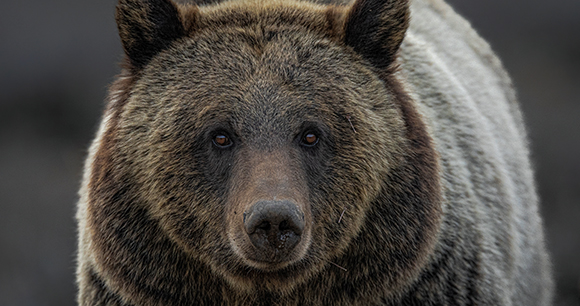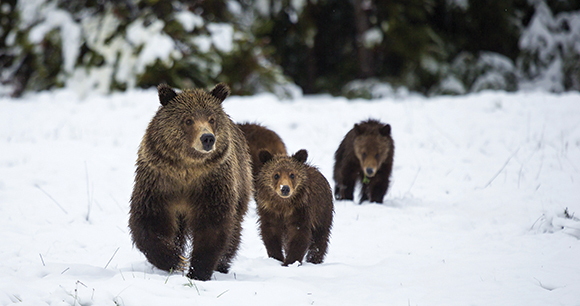The grizzly bear—sometimes referred to as the “great bear”—is a study in contrasts: powerful yet vulnerable, long-studied but mysterious, admired and feared. Grizzlies have inhabited North America for tens of thousands of years, persisting through the end of the last ice age even as many of their competitors—such as the giant short-faced bear and saber-toothed cat—went extinct.

In the early 1800s, some 50,000 grizzlies roamed most of the western United States. However, the combination of westward expansion by European settlers and state and federal predator extermination campaigns slashed the grizzly bear population in the contiguous 48 states to less than 2 percent of its pre-settlement population size and range. By 1975—the year they were listed as “threatened” under the Endangered Species Act (ESA)—as few as 700 animals remained. Although the population has grown slowly in the decades since, as of last year, there were only about 2,000 individuals occupying around 6 percent of their historical range.
Today, most grizzlies in the contiguous 48 states live in one of two regions: the Northern Continental Divide Ecosystem (NCDE) in northwestern Montana, and the Greater Yellowstone Ecosystem (GYE) surrounding Yellowstone National Park. Twice in the last 15 years, the US Fish and Wildlife Service has removed ESA protections from Yellowstone-area grizzlies—despite the threats posed by climate change, high mortality levels due to conflicts with humans, and the prospect of diminished long-term genetic health due to more than a century of isolation from other grizzly populations. Twice, federal courts have intervened and restored those protections.
That hasn’t stopped grizzly bear detractors from trying again. Last year, Montana legislators adopted a resolution calling on the USFWS and Montana’s congressional delegation to delist all grizzlies in Montana. Federal lawmakers from both Montana and Wyoming introduced legislation that would remove protections from NCDE bears, GYE bears, or both, and exempt those actions from judicial review. Separately, in December, Montana’s governor petitioned the USFWS to delist bears in northwestern Montana. And in January, Wyoming’s governor submitted a request to remove federal protections—yet again—from the Yellowstone population.
Montana, Wyoming, and Idaho also recently approved an agreement governing how many GYE grizzly bears each state would be allowed to kill through hunting and other management activities if ESA protections are removed. A desire to allow grizzly hunting is one reason why some legislators and state wildlife agencies want to see the animals delisted and their management handed back to the states. Some believe that hunting would reduce human-grizzly conflicts or make bears more wary and frightened of people. There is little evidence for either of these claims. For example, studies of grizzly bears in British Columbia and Norway, American black bears in Wisconsin and Ontario, and Asiatic black bears in Japan have found no correlation between numbers of bears killed by hunters and numbers of human-bear conflicts. The study authors offered several possible explanations.
First, bears killed by hunters often live in remote areas, so bears targeted by hunters are often not the same individuals as those involved in run-ins with humans. Second, even if some of the bears in a hunted population were involved in conflicts, it is unlikely hunters would be able to distinguish them from nonconflict bears. Third, even if a “nuisance” bear is killed by a hunter, it is likely that another bear will move into the vacated territory, starting the problems anew.
There is also little evidence that hunting bears would teach them to be more frightened of people. As numerous bear biologists have pointed out, dead bears cannot learn. On the contrary, hunting grizzlies could actually increase rare attacks on people: More hunters in grizzly bear country, moving slowly and silently, and often alone, could result in more startled bears, which could result in more human injuries and deaths.

Another important reason why grizzly bears should not be hunted is that the states where grizzlies live have already foreshadowed how reckless their management of the bears would likely be. For example, months after the 2018 temporary delisting of Yellowstone-area grizzlies, Wyoming proposed to allow more than 20 of the animals to be gunned down—over bait in some areas. Bear baiting is highly problematic because any bear lured to a bait site and not killed by a hunter could learn to associate the scent of humans with food and come into more conflict with humans as a result.
In another telling example, last year the Montana legislature passed a raft of bills designed to dramatically reduce the state’s wolf population through measures such as allowing the use of neck snares and night hunting, extending the trapping season, and authorizing the equivalent of a bounty program to reimburse wolf trappers and hunters for their expenses. As a group of 35 prominent Montana state, federal, and tribal wildlife biologists opposed to grizzly delisting explained in a widely published op-ed, “It doesn’t take a lot of imagination to realize that if grizzly bears were delisted and turned over to state management, that the Legislature and governor would do the same thing to grizzlies that they are currently doing to wolves.”
As we monitor federal and state actions affecting grizzlies, AWI is also working to reduce human-bear conflicts on the ground. We’ve helped purchase dozens of bear-resistant garbage containers for residents of rural communities in grizzly habitat, and we are working with officials in Bozeman, Montana, to reduce encounters between residents and bears (both black and grizzly) in town. This work is important because it demonstrates the effectiveness of nonlethal measures to keep both people and bears safe—and helps refute claims that delisting and hunting are necessary.
Grizzly bears inspire awe and stir our appreciation for what remains wild and primal and free. After four decades of federal protection, grizzlies still occupy only a tiny fraction of their historical habitat in the contiguous 48 states. As the great bear continues to recover, it deserves our help, not premature removal of federal protections or senseless hunting seasons that could wipe out decades of progress.